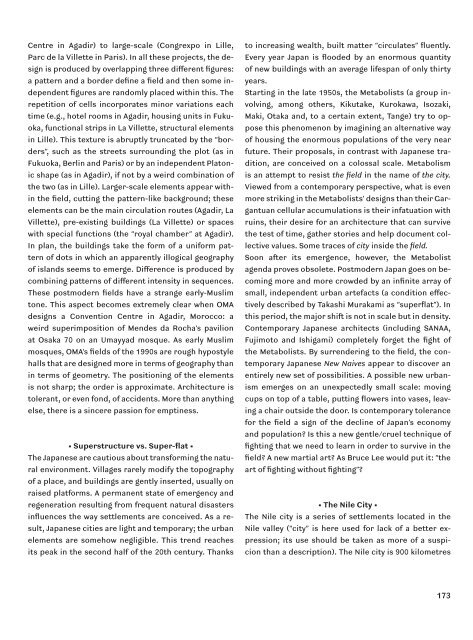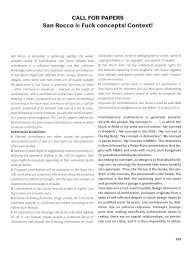CALL FOR PAPERS San Rocco 2: The Even Covering of the Field
CALL FOR PAPERS San Rocco 2: The Even Covering of the Field
CALL FOR PAPERS San Rocco 2: The Even Covering of the Field
You also want an ePaper? Increase the reach of your titles
YUMPU automatically turns print PDFs into web optimized ePapers that Google loves.
Centre in Agadir) to large-scale (Congrexpo in Lille,<br />
Parc de la Villette in Paris). In all <strong>the</strong>se projects, <strong>the</strong> design<br />
is produced by overlapping three different figures:<br />
a pattern and a border define a field and <strong>the</strong>n some independent<br />
figures are randomly placed within this. <strong>The</strong><br />
repetition <strong>of</strong> cells incorporates minor variations each<br />
time (e.g., hotel rooms in Agadir, housing units in Fukuoka,<br />
functional strips in La Villette, structural elements<br />
in Lille). This texture is abruptly truncated by <strong>the</strong> “borders”,<br />
such as <strong>the</strong> streets surrounding <strong>the</strong> plot (as in<br />
Fukuoka, Berlin and Paris) or by an independent Platonic<br />
shape (as in Agadir), if not by a weird combination <strong>of</strong><br />
<strong>the</strong> two (as in Lille). Larger-scale elements appear within<br />
<strong>the</strong> field, cutting <strong>the</strong> pattern-like background; <strong>the</strong>se<br />
elements can be <strong>the</strong> main circulation routes (Agadir, La<br />
Villette), pre-existing buildings (La Villette) or spaces<br />
with special functions (<strong>the</strong> “royal chamber” at Agadir).<br />
In plan, <strong>the</strong> buildings take <strong>the</strong> form <strong>of</strong> a uniform pattern<br />
<strong>of</strong> dots in which an apparently illogical geography<br />
<strong>of</strong> islands seems to emerge. Difference is produced by<br />
combining patterns <strong>of</strong> different intensity in sequences.<br />
<strong>The</strong>se postmodern fields have a strange early-Muslim<br />
tone. This aspect becomes extremely clear when OMA<br />
designs a Convention Centre in Agadir, Morocco: a<br />
weird superimposition <strong>of</strong> Mendes da Rocha’s pavilion<br />
at Osaka 70 on an Umayyad mosque. As early Muslim<br />
mosques, OMA’s fields <strong>of</strong> <strong>the</strong> 1990s are rough hypostyle<br />
halls that are designed more in terms <strong>of</strong> geography than<br />
in terms <strong>of</strong> geometry. <strong>The</strong> positioning <strong>of</strong> <strong>the</strong> elements<br />
is not sharp; <strong>the</strong> order is approximate. Architecture is<br />
tolerant, or even fond, <strong>of</strong> accidents. More than anything<br />
else, <strong>the</strong>re is a sincere passion for emptiness.<br />
• Superstructure vs. Super-flat •<br />
<strong>The</strong> Japanese are cautious about transforming <strong>the</strong> natural<br />
environment. Villages rarely modify <strong>the</strong> topography<br />
<strong>of</strong> a place, and buildings are gently inserted, usually on<br />
raised platforms. A permanent state <strong>of</strong> emergency and<br />
regeneration resulting from frequent natural disasters<br />
influences <strong>the</strong> way settlements are conceived. As a result,<br />
Japanese cities are light and temporary; <strong>the</strong> urban<br />
elements are somehow negligible. This trend reaches<br />
its peak in <strong>the</strong> second half <strong>of</strong> <strong>the</strong> 20th century. Thanks<br />
to increasing wealth, built matter “circulates” fluently.<br />
Every year Japan is flooded by an enormous quantity<br />
<strong>of</strong> new buildings with an average lifespan <strong>of</strong> only thirty<br />
years.<br />
Starting in <strong>the</strong> late 1950s, <strong>the</strong> Metabolists (a group involving,<br />
among o<strong>the</strong>rs, Kikutake, Kurokawa, Isozaki,<br />
Maki, Otaka and, to a certain extent, Tange) try to oppose<br />
this phenomenon by imagining an alternative way<br />
<strong>of</strong> housing <strong>the</strong> enormous populations <strong>of</strong> <strong>the</strong> very near<br />
future. <strong>The</strong>ir proposals, in contrast with Japanese tradition,<br />
are conceived on a colossal scale. Metabolism<br />
is an attempt to resist <strong>the</strong> field in <strong>the</strong> name <strong>of</strong> <strong>the</strong> city.<br />
Viewed from a contemporary perspective, what is even<br />
more striking in <strong>the</strong> Metabolists’ designs than <strong>the</strong>ir Gargantuan<br />
cellular accumulations is <strong>the</strong>ir infatuation with<br />
ruins, <strong>the</strong>ir desire for an architecture that can survive<br />
<strong>the</strong> test <strong>of</strong> time, ga<strong>the</strong>r stories and help document collective<br />
values. Some traces <strong>of</strong> city inside <strong>the</strong> field.<br />
Soon after its emergence, however, <strong>the</strong> Metabolist<br />
agenda proves obsolete. Postmodern Japan goes on becoming<br />
more and more crowded by an infinite array <strong>of</strong><br />
small, independent urban artefacts (a condition effectively<br />
described by Takashi Murakami as “superflat”). In<br />
this period, <strong>the</strong> major shift is not in scale but in density.<br />
Contemporary Japanese architects (including SANAA,<br />
Fujimoto and Ishigami) completely forget <strong>the</strong> fight <strong>of</strong><br />
<strong>the</strong> Metabolists. By surrendering to <strong>the</strong> field, <strong>the</strong> contemporary<br />
Japanese New Naives appear to discover an<br />
entirely new set <strong>of</strong> possibilities. A possible new urbanism<br />
emerges on an unexpectedly small scale: moving<br />
cups on top <strong>of</strong> a table, putting flowers into vases, leaving<br />
a chair outside <strong>the</strong> door. Is contemporary tolerance<br />
for <strong>the</strong> field a sign <strong>of</strong> <strong>the</strong> decline <strong>of</strong> Japan’s economy<br />
and population? Is this a new gentle/cruel technique <strong>of</strong><br />
fighting that we need to learn in order to survive in <strong>the</strong><br />
field? A new martial art? As Bruce Lee would put it: “<strong>the</strong><br />
art <strong>of</strong> fighting without fighting”?<br />
• <strong>The</strong> Nile City •<br />
<strong>The</strong> Nile city is a series <strong>of</strong> settlements located in <strong>the</strong><br />
Nile valley (“city” is here used for lack <strong>of</strong> a better expression;<br />
its use should be taken as more <strong>of</strong> a suspicion<br />
than a description). <strong>The</strong> Nile city is 900 kilometres<br />
173




